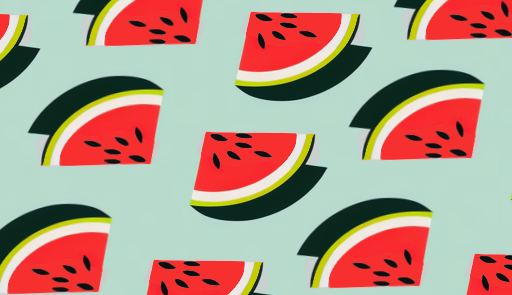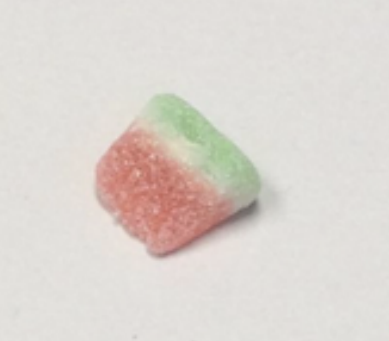
0%

On September 7, 2023, the United States Court of Appeals for the Third Circuit decided PIM Brands Inc., v. Haribo of America Inc. Presiding over a dispute between two candy companies, the Third Circuit affirmed the District Court’s invalidation of PIM's federal trademark registration in its watermelon-esqe trade dress, finding it to be functional.
In 2003, PIM began selling wedge-shaped, green-white-and-red-colored watermelon-flavored candies under the branding Sour Jacks Wedges. In 2016, PIM obtained a federal trademark registration in its mark consisting of “the shape of a wedge for candy, with an upper green section with white speckles, followed by a narrow middle white section and followed by a lower red section with white speckles.”

PIM’s mark as it appears on its registration certificate.
Haribo recently introduced its own wedge-shaped candy, exhibiting a similar color presentation to that of PIM, contending that it chose to design its candy’s shape and color to match its flavor: watermelon.
PIM sued Haribo for trademark and trade-dress infringement on the basis of this candy; Haribo countered by arguing that PIM’s trade dress was functional and asked the court to cancel the registration.
Because PIM had obtained a federal registration in its trade dress which was entitled to a presumption of validity, Haribo bore the burden at the District Court to introduce proof of functionality. According to both the District Court, and now the Court of Appeals, Haribo successfully overcame this evidentiary requirement.
The Third Circuit first addressed the framework through which it would assess the question of functionality. The Court outlined two questions that needed to be answered before the case at hand could be evaluated.
What design choices are for branding purposes only, and which design choices stray into unprotectable functional elements of a product?
The Court relayed that:
Functionality is not a high bar. Trade dress is limited to design choices that serve only to brand a product. If a design choice “would put competitors at a significant non-reputation-related disadvantage,” then it is functional. Even if the design chosen both promotes a brand and also “makes a product work better,” it is functional and unprotectable.
Should product color and product shape be assessed together or separately?
Where the two design elements serve the same purpose, functionality is to be analyzed together. Two design elements should only be analyzed separately if they have unrelated functional qualities. Here, both elements serve the same function and are to be evaluated in tandem, as can be seen below.
With that basis established, the Court then addressed the matter at issue, answering the question:
What function does PIM’s combination of shape and color serve for its candy product?
For the average consumer – who is familiar with the shape and color of watermelon as well as with its taste – PIM’s candy trade dress serves as an indication of flavor. PIM’s choice in color and in shape both served the same functional purpose of emulating what a slice of watermelon looks like.
In fact, the Court noted that it was the combination of elements that PIM mimicked from the real fruit that caused a finding of functionality, offering that “[s]ome shapes for watermelon candies, such as sharks, ropes, and ribbons, detract from . . . the colors. But the wedge shape contributes to the function. The colors alone could leave some ambiguity: Is it watermelon or strawberry? With the wedge shape, all ambiguity is gone—this candy is a wedge of watermelon.”
A candy company that makes the arbitrary decision to design its watermelon-flavored candy in the shape of a bear will be capable of gaining trademark protection in this trade dress because this decision does not serve a functional purpose. Applying this principle to candy generally, a company may not be able to seek trademark protection for the rectangular shape of its chocolate bar, but Hershey’s may be able to seek protection for the conical, teardrop shape of its Kiss chocolates.
So too a candy company that chooses to make its watermelon-flavored candy blue may be capable of obtaining trade dress protection (so long as blue does not have another functional purpose, say, being the natural color of the candy before dyes are added). Arbitrary color choices have long been recognized as functioning as an indication of source: pink for fiberglass insulation, green-gold for dry cleaner press pads, and red-colored heels for women’s shoes.
But design choices that are functional – here, the reminiscence of a candy’s color and shape to evoke expectations of flavor – cannot serve as trademarks, and companies therefore cannot rely on trademark law to prevent its competitors from making similar functional design decisions. A candymaker cannot claim exclusive use to the color yellow for its lemon-flavored products or blue for its blueberry-flavored products, as these colors function to indicate flavor to consumers. Likewise, a candymaker cannot prevent competitors from manufacturing brown or white chocolates, as these are the natural colors of chocolate once all its ingredients are combined.
A reminder that, for those design choices that do not sound in functionality, they are not immediately protectible under the Lanham Act. Instead, an arbitrary design element is only capable of indicating the source of a product after it has acquired secondary meaning. For example, in Qualitex, the Supreme Court found Qualitex’s green-gold color choice to be a protectable trade dress because it was identified as Qualitex’s by consumers (indicating source) and there was “no competitive need in the press pad industry for the green-gold color, since other colors are equally usable.”
Summary: This watermelon candy case clarifies (within the Third Circuit) how design elements (shape, color, etc.) should be assessed when they combine to serve a singular functional purpose.
To view a version of this article with full citations in footnote form, click the PDF link here.